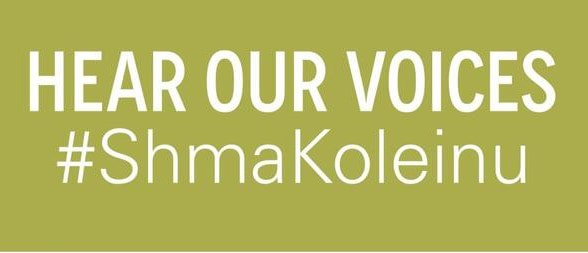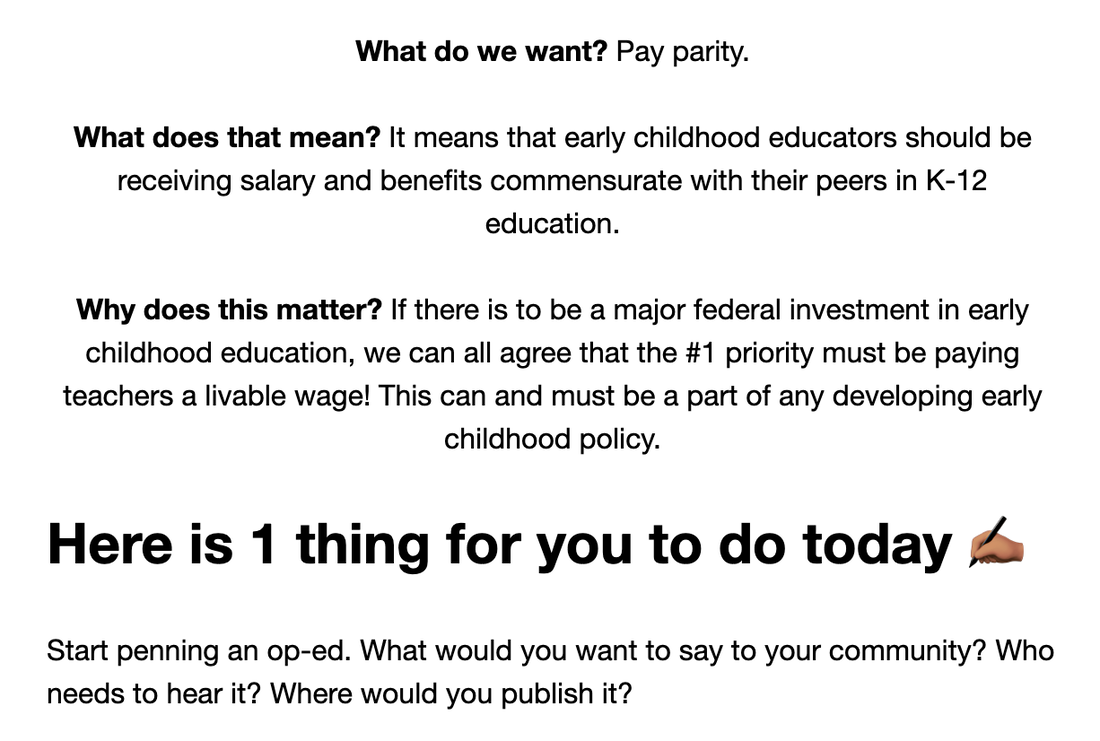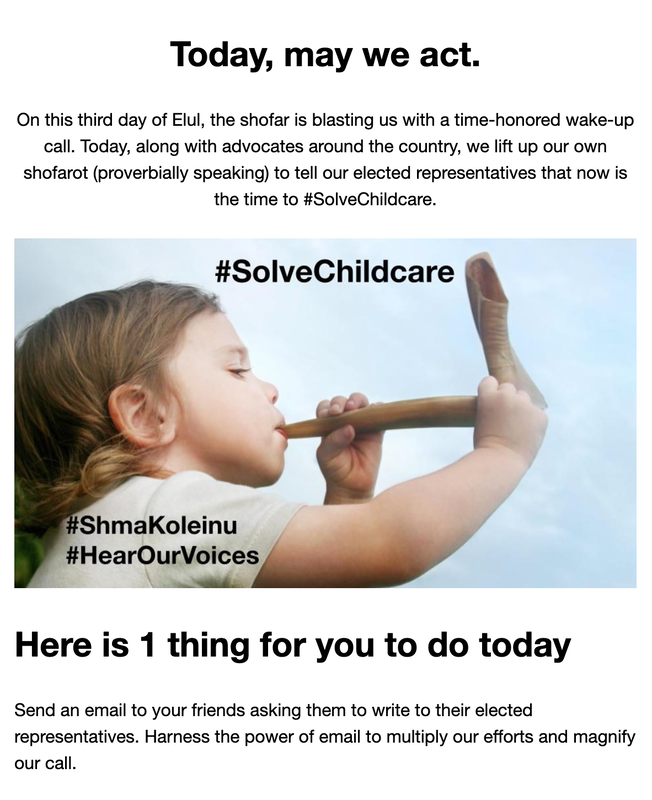|
Greetings from the Block Grant Initiative! Since we last met, an amazing milestone occurred: the passage of the American Rescue Plan Act. This Act was passed in the House on February 27, and then it moved over to the Senate, where it was passed on March 6. On March 10, the House of Representatives voted to approve the changes made by the Senate, and then they sent the bill to the President, who signed it into law on March 11.
As you know, this Act did three things that are relevant to Shma Koleinu: Number one, it brought families stimulus checks and numerous tax credits. Number two, it funded $15 billion for CCDBG, providing child care assistance to children in families with low incomes. And number three, it directed $25 billion for Emergency Stabilization for the childcare industry, benefiting centers. All told, this Act realized and brought to a close a yearlong campaign to bring $50 billion to the childcare sector. We want to pause for a moment: You were part of this. You’ve listened and learned You’ve shared stories. You have become an advocate. Ba-ruch A-tah A-do-noi E-loi-hei-nu Me-lech ha-o-lam she-he-chee-ya-nu v'ki-yi-ma-nu vi-hi-gi-ya-nu liz-man ha-zeh. Blessed are You, L-rd our G‑d, King of the Universe, who has granted us life, sustained us and enabled us to reach this occasion. Take a moment to pat yourself on the back. To reflect on the journey and the shifting paradigm. We invite you to take a moment and share in the chat one piece of learning you have taken from this experience thus far. Also since we last met, we hosted webinars that helped all of us, plus the wider network of Shma Koleinu advocates, get to know and learn from advocates in Washington. This process of building our knowledge is vital. There is much to learn to get literate in government policy and funding for ECE. From the National Council for Jewish Women, we heard about how the America Rescue Plan Act and its provisions for families are having more than a modest impact: they are cutting childhood poverty in half. This is a reminder to early childhood advocates that, in the words of Marianne Williamson, we are powerful beyond measure, and our playing small doesn’t serve the world. That is, when funded properly, early childhood education and investing in children and families IS as powerful as we have always suspected. At this week’s webinar with the National Women’s Law Center, we learned that advocates must be bold in telling the truth about what is needed and that we must not be limited by what is politically possible. Recently, our Initiative has focused on where CCDBG and Stabilization funds go when they get to the state level. Here is what we learned: Every state is different. For our own literacy and effectiveness, Shma Koleinu advocates in every state need to know how federal funds supporting ECE arrive in their home states and where they go next. We jokingly talk about this process as being able to summarize complex ideas with the confidence and conciseness of a report a 4th grader might give in school. We suggest this be a goal for all of us--to understand and be able to articulate how and where money comes into our own states for ECE; how it gets spent; and by whom. This process will take time to investigate and internalize. Be aware that this is an area for growth for each of us and we want to say thank you to the block grant members who have begun doing the work to support us in this deep dive. Here is an example of what you might learn as you embark on this process of learning about your own state: In Connecticut, our state officials are not as transparent about things as we believe they should be. For example, we have an Office of Early Childhood, but it does not make clear exactly what programs it funds. It should not be this hard to figure out how our money is being spent. The majority of CCDBG funds in Connecticut go to Care for Kids, which is our subsidy for low-income families. Only these subsidies don’t fund parents who are in school—it is only for parents with full-time jobs. And the funds only cover 25% of the tuition. And parents have to reapply every month. Money also goes to QRIS, school readiness programs, and technical assistance to family-based child care. We have had a problem in Connecticut with unlicensed home providers--in recent years, children have died in unlicensed home-based care, leading to some really significant funds toward licensing and providing CPR and first aid training for these providers. As for American Rescue funds, a significant amount of them will go directly to centers. This will come out soon as a one-time payment of as much as $600 per child. These funds will also support Care for Kids, the program where low income families can access a subsidy to be used at child care centers or family childcare or even to pay a family member who looks after a child. The American Rescue Plan will make it easier for families to access these funds--parents or guardians will be able to get these funds while in job training or in school, and they will be able to apply in 12-month increments. The funds will cover training for and accreditation by NAEYC for interested centers. Most importantly, out of the money that comes in to providers, 24% of funds must go directly and immediately to your currently employed ECE staff either as a bonus or a raise. In Illinois, CCDBG pays for quality improvement and PD; projects run by child care resource and referral agencies (a category known as a CCR&Rs); data systems; and ECE subsidies for low income families. These subsidies, called CCAP in Illinois, are paid for by CCDBG as well as a number of other sources. Stabilization dollars from the American Rescue Plan make three things possible: (1) Enabling the state to pay centers accepting CCAP for all eligible days of childcare regardless of the child’s attendance; (2) Providing PPE to childcare providers across the state; and (3) Restoration Grants, which provide as much as 30k per month to our full-day, licensed centers. In New York, the Office of Children and Family Services is the centralized place where many federal funds come in and from which they get disbursed around the state. In my research I learned about an advocacy organization called Empire State Child Care, which also consolidates information coming out of the state budget. From them I learned that last week the NY Legislature passed a budget for FY21-22 that has numerous investments in childcare ($2.4 billion), including new universal Prek classrooms, expanded QRIS, and additional subsidies for low income families. The budget also calls for $1.3 billion in stabilization grants to support expenses, as well as additional funds for cleaning and safety. In general, we found in our research, states vary in their transparency and coordination. What stands out in all states is the alphabet soup of organizations that are involved and the variety of government grants that are funding state programs. There is surely much learning for us all to do. And mistakes we will make as we do. Looking ahead, as many of our speakers have told us, we know that we need long-term, sustained investments and solutions in order to make the change we seek. Our Initiative expects to foster a grassroots campaign to support President Biden’s Infrastructure Bills, known as the American Jobs Plan. In addition, we intend to dream big and ask ourselves what a bold vision for federal funding could and should look like and what that could mean for Jewish early childhood programs. The block grant team of Shma Koleinu is focused on advocating for federal funding for early childhood education, with a focus on learning more about the Child Care and Development Block Grant, also known as CCDBG. What is CCDBG? Here is a two-minute video that introduces CCDBG. As a legislative update, you may recall that President Biden published his American Rescue Plan in January. It then went to the House of Representatives, which passed the bill on February 27. It is currently being considered and adapted for the Senate. The portions relevant to early childhood education are twofold: they are (1) grants and (2) tax credits. In terms of grants, the bill includes $15B for CCDBG, which benefits children in families with low incomes, and $25B for Emergency Stabilization for the childcare industry, which benefits centers. As for the tax portion of the bill, there is a provision for child care tax credits, benefiting families across the U.S.
This bill needs our support in order to make it through the Senate. We believe this bill will be historic. As Senator Patty Murray has said, “The American Rescue Plan marks a historic shift in how our country approaches child care. It will allow providers to stay open and better support families who need help affording quality child care — and it also sets a new precedent for finally prioritizing economic policies that support working women and families. I’m looking forward to getting this across the finish line.” We have one action item that we are requesting of every Shma Koleinu member, which is as follows: Follow the link that Anna is now putting in the chat, which includes instructions for placing a phone call your senator. We ask that you do this today and that you share the link with your networks. What is ahead for our Initiative? In the coming months, we will begin a process of learning about how each of our individual states utilizes both the CCDBG funds and the Emergency Stabilization funds, with an eye toward leveraging learnings from one state to bolster activism in others. Finally, we have lined up a dynamic team of policy leaders to teach an intensive summer series on the history of American early childhood policy and funding. This course will be an element of ECEpalooza, powered by the Paradigm Project and the Sheva Center at the JCC Association of North America. |
Categories
All
Archives
March 2023
|




 RSS Feed
RSS Feed